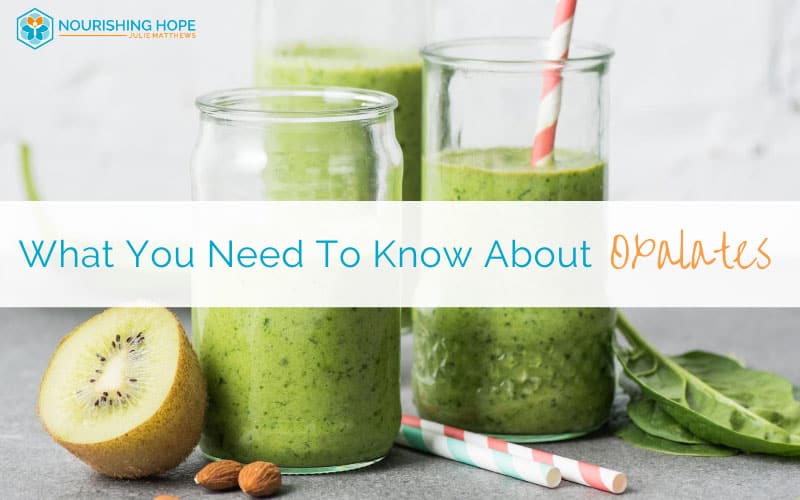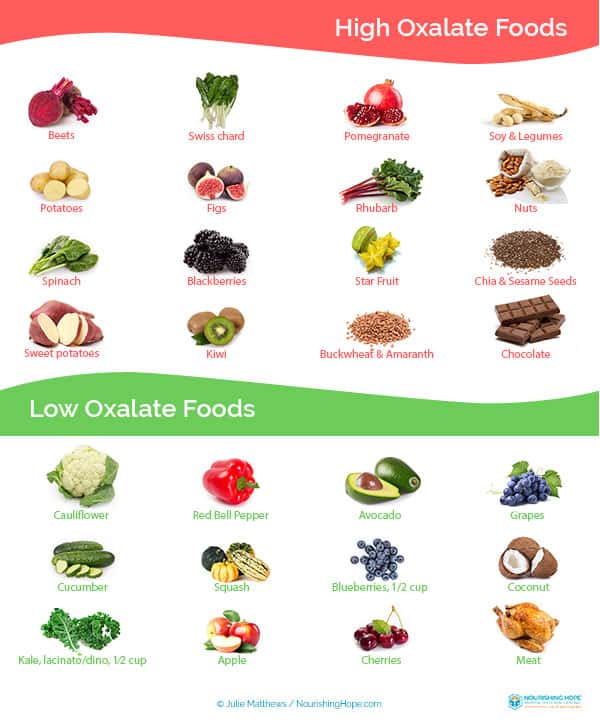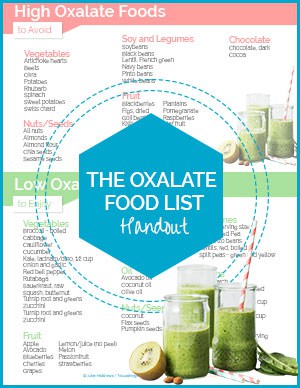
Oxalates are highly reactive molecules found in certain foods. They create pain and inflammation in the body, particularly for certain people.
Oxalates are found in high amounts in spinach, swiss chard, nuts, sweet potatoes, beets, chocolate, and many other foods.
They bind with certain minerals; particularly calcium and magnesium, as well as iron and copper – so they are often (but not always) found in foods rich in calcium.
High oxalate in the body (hyperoxaluria) can be a factor in many chronic conditions; including digestive issues, autoimmune disorders, and neurological conditions. Oxalates affect mitochondrial function and can create inflammation; thus influencing every system in the body.
Having high oxalate in the body can be problematic; and not giving proper consideration to one’s oxalate intake can impede the effectiveness of even the best healing diet protocol.
Unfortunately, because they bind to these minerals they render the minerals unavailable, so a food that’s seemingly “healthy” because it is rich in calcium like spinach can actually deplete us of those very minerals.
Oxalates can cause or contribute to hypothyroid function, autoimmune conditions, autism, vulvodynia, asthma, kidney stones, cystic fibrosis, headaches, and other chronic conditions. (See my article on Oxalates and Chronic Disease for more conditions and underlying contributing factors to oxalate issues and my article on the research behind Oxalates and Autism.)
Oxalates can be a problem when: the gut is inflamed and hyper-permeable (i.e. leaky gut), fat is not digested and there is fat malabsorption, or when there is not enough good bacteria (especially particular forms) to break the oxalate down. Developing problems with oxalates is more likely if there aren’t enough minerals in the gut to bind the oxalate.
Although most commonly identified with the formation of calcium oxalate kidney stones (oxalate bound to calcium), when unbound, free oxalate can interfere with cellular functions; affecting health on a broader, systemic level. Clinical studies and anecdotal experience indicate that oxidative stress, mitochondrial disruption and damage, and nutrient depletions, trigger widely varied symptoms including fatigue and inflammatory cascades, joint pain or pain anywhere in the body. Chronic low energy is very common because of a reduction in ATP in the mitochondria. Oxalates could be a hidden source of headaches, urinary pain, genital irritation, joint, muscle, intestinal or eye pain.
Other common oxalate-caused symptoms may include mood conditions, anxiety, sleep problems, weakness, or burning feet. Indicators can be digestive upset, respiratory issues, or even bedwetting for children.
Where Does Oxalate Come From
Oxalates stem from two main sources: exogenous (outside the body; from dietary intake) and endogenous (produced within the body, cell or tissue).
Exogenous oxalate can accumulate from a diet that is high in spinach, nuts, beans, or other high oxalate foods. This is why individualizing therapeutic diets is essential. Diets often heavy on these nut flours include: SCD, GAPS, and Paleo. And vegetarian diets are often high in oxalate; since they usually include many beans, grains, nuts and seeds, as well as high oxalate greens or starchy vegetables, like spinach or sweet potatoes.
Endogenous oxalate comes from oxalate generated internally inside the cell, and sometimes it comes from substances that don’t contain oxalate but that convert to oxalate often due to nutrient deficiencies such as vitamin B6.
Implementing a Low Oxalate Diet
Implementing a low oxalate diet can help reduce pain, improve digestion and the microbiome, improve mood, and support growth in children.
Making informed choices or modifying a diet for oxalate can make a dramatic difference in lowering the oxalate load. Please note: it is important to reduce oxalates in the diet very slowly.
Adding supplements such as calcium to bind oxalates can also help while reducing oxalates in the diet. Additionally, supplements that combat oxidative stress and those that boost nutrient deficiency that cause endogenous oxalate production can also help.
A nutrition practitioner well versed in oxalates can help guide you.
Practitioners should be aware that diets high in oxalate could create a wide variety of problems for some people. To learn more about when and how to help your clients implement a low oxalate diet, visit the BioIndividual Nutrition Training program.
For parents or individuals interested in learning about diet and nutrition including the low oxalate diet for their child (or an adult with ADHD, autism, or other neurological condition), join our nutrition program for parents, Nourishing Hope for Healing Kids.






I dont see any references, can you share them plz?
I listened to your talk about the effect of oxalates on calcium absorption over the weekend as part of the Margie Bissinger presentations and was in shock by how many foods I eat EVERY DAY on the high oxalate list. I am upset that I have given myself the osteopenia and osteoporosis (one hip each) that I have. I am taking a hormone blocker because of breast cancer (3 years ago) and am now on Boniva because of my fracture risk. I knew about the spinach problem, but not all the other things that are the major part of my diet.
Do you do consultations? I like my hematologist, but I don’t think he is aware of this major contributor to bone loss. Can you help?
Thanks for your comment Theresa. Julie has articles and recipes all related to the Low Oxalate diet, you can find some here: https://nourishinghope.com/?s=low+oxalate
Julie is not doing 1 on 1 consultations at this time but Julie also create the BioIndividual Nutrition Institute and trains practitioners on these complex nutrition principles. If you email me at terri@nourishinghope.com, we can seek a BioIndividual Nutrition practitioner for you. ~Terri, Team Nourishing Hope